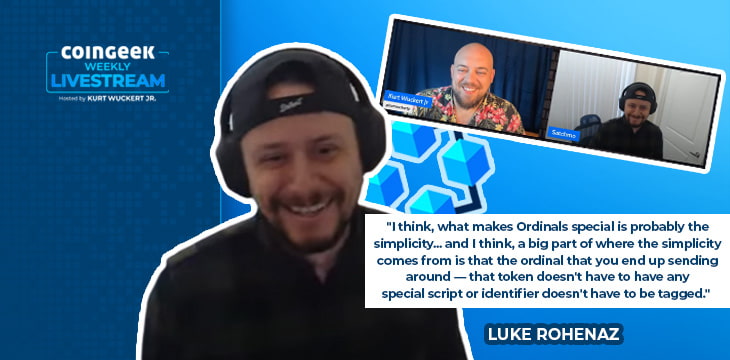
|
Getting your Trinity Audio player ready... |
On this episode of the Coingeek Weekly Livestream, TonicPow founder Luke Rohenaz explains the utility and value of Ordinals on Bitcoin SV (BSV).
What is Ordinals?
Wuckert opens the show by refreshing us on what the Ordinals protocol is. It’s a token protocol created by a developer named Casey Rodarmor on BTC.
“It was essentially, hey, color a sat and put stuff on it,” Wuckert says.
He notes that people have been trying to do this for a long time, but every attempt has been stifled, resulting in Ethereum and many other altcoins.
BSV itself has had a token explosion, including RUN, STAS, Simple Fabric tokens, ELAS tokens, and others. The problem is there was no unification around one token protocol. Suddenly, Ordinals took BTC by storm, quickly bouncing to Litecoin, Doge, and even Monero. Now, they’ve made their way to BSV.
What makes Ordinals interesting?
Wuckert asks Rohenaz for a high-level overview of what makes Ordinals interesting as a protocol.
“We’ve had a bunch with different flavors,” Rohenaz reflects. Ordinals is different because of its simplicity. Ironically, this is because of the technical limitations of BTC; something simple was the only thing possible. It doesn’t require any sort of script or tagging and relies only on an indexer to keep track of Ordinal IDs.
Wuckert notes that STAS tokens were supposed to take over a couple of years back. He asks Rohenaz for a brief comparison of them compared to Ordinals. He answers that there’s a difference in how they work, but also network effects, interest, and familiarity. Combined with good documentation, it’s easy for people to just hop in and build something, which wasn’t the case with some other token protocols.
While ease of use is part of the appeal, there are some technical differences, too, Rohenaz says. STAS has its own locking script, which enforces that the output is the same as the input. This script adds some weight that has to be sent around, and then it needs to be interpreted.
“The script is what is defining the boundaries of the token and how to identify it. In Ordinals, you don’t need this; the identifier is inherent because you’re using an indexer to trace back UTXOs.”
What are the fundamental differences between the BTC and BSV versions of Ordinals?
BTC has to use SegWit and Taproot as workarounds to store data on the blockchain. They have to make a commit transaction, sign it, and put the data in during the signing process, Rohenaz explains. As this involves two steps and transactions, they have to pay the network fees twice as well, not to mention the added complexity involved.
On BSV, we don’t need two steps; we just put it in the output. However, we do put it in an output script and follow the same exact script format they use, Rohenaz tells us. Hypothetically, there could be use cases like cross-chain swaps.
What other things are limited on BTC but not on BSV? Rohenaz lists the ability to put OP_RETURN data, unique Bitcoin script, and things like metadata and tagging. Rohenaz inscribed a 3D model of a crystal item which also has metadata that tags it to a specific geohash. Giving another example of what can be done on BSV that can’t be replicated on BTC, he imagines an inscription of an egg that hatches after some time.
How have we been able to unite the clans so quickly?
Wuckert has pointed out many times that one of the major issues in BSV is the inability of developers, entrepreneurs, and others to unite around one token protocol. He notes that Ordinals seems to have done the trick and wonders why.
Rohenaz supposes there are a few reasons. The simplicity is a big thing; there’s always a deal breaker with other token protocols, but not this one. It’s also not seen as a competitive protocol within the BSV ecosystem—it came from the outside. The hype about it on other chains also helps.
“It’s a combination of multiple things,” he says.
Wuckert points out that it’s possible to have special token protocols for specific use cases on Ethereum, too, but that most people have decided on ERC-20 as the standard. He wonders what things will look like in six months if everyone in BSV makes their wallets and apps Ordinals compatible while having their walled gardens for their specific use cases and clients.
What was the launch process like? Why does it matter?
The idea for how to do this came from feedback, Rohenaz explains. People had complained that people like him would mint the low number Ordinals.
However, mostly due to testing, only a couple of inscriptions on the chain were put there before the launch date. People didn’t want them to be considered not part of the valid set by being there before the official launch date. So, in this way, it was a truly fair launch.
Explaining the mining side of things, Wuckert says he was asked to mine a certain coinbase string. This started a 218-block countdown to the official launch. Any inscriptions after this would be considered legit and valid Ordinals inscriptions.
Trollbox questions from the audience
Q. Do I need to run a full node to validate inscription numbers?
No. Anyone could use the JungleBus API to subscribe to the ORD data type to get a feed of this data. Doing so would give each and every Ordinals going back to the first one.
Q. Why not just spawn an OP_RETURN on each transfer? Since BSV can’t emulate the SegWit signatures, it can’t do true Ordinals.
Rohenaz says that while it can’t be done the exact same way, and it won’t be identical, it does stay true to the spirit of the original protocol.
Q. If Ordinals were so easy to launch, why didn’t we have it sooner?
Wuckert says many people were trying to solve too many problems at once. Rohenaz says he didn’t care which one it would be as long as people united around it. He says the big innovation here is the Ordinals numbering system. This is the big thing that wasn’t obvious on other token protocols, which is perhaps why nobody spotted it sooner.
Q. If BTC and other chains are already doing Ordinals, why is it good for BSV to have them?
Rohenaz says there were some limitations with some of the other token protocols he has used previously. These issues won’t be an issue with Ordinals; it’s truly open with no licensing requirements to use. The opportunity to unite different people and groups would also be invaluable for BSV. Wuckert sees an opportunity to bring in new developers who may hit limitations on other blockchains and then discover they can bring their ideas to life on BSV.
Q. Why just one sat Ordinals? Is it possible to make variable sat Ordinals so people can choose the number that works best for their use case?
Rohenaz does not believe it will stay one sat forever. That’s just the starting point, and the name will stay that way because it communicates that they can be done. In time, ranges will become possible.
Q. If you need one satoshi per inscription, isn’t there a finite number of inscriptions possible? Is this good for the demand for Satoshis?
Wuckert answers that there can only be 2.1 quadrillion Ordinals. If we reach the point of running out, this has all been very successful, and someone can be paid to engineer a new solution. Rohenaz points out that you can reinscribe as many times as you want, so it’s theoretically infinite.
Vaionex: Frictionless Blockchain Solutions

 11-22-2024
11-22-2024


